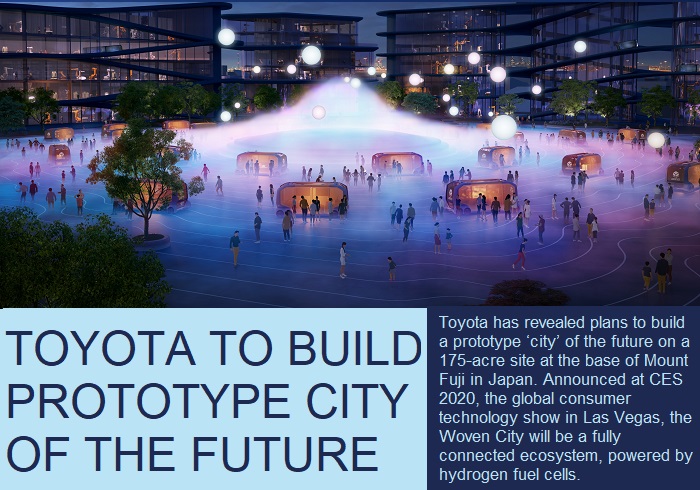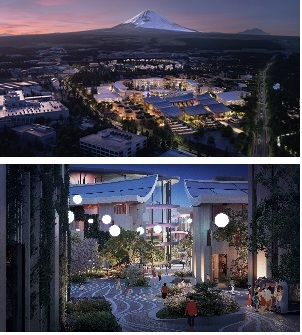Toyota has revealed plans to build a prototype ‘city’ of the future on a 175-acre site at the base of Mount Fuji in Japan.

Announced at CES 2020, the global consumer technology show in Las Vegas, the Woven City will be a fully connected ecosystem, powered by hydrogen fuel cells.
Envisioned as a ‘living laboratory,’ the city will be home to full-time residents and researchers who will be able to test and develop technologies such as autonomy, robotics, personal mobility, smart homes and artificial intelligence in a real-world environment.
 Akio Toyoda, Toyota Motor Corporation President said, “Building a complete city from the ground up, even on a small scale like this, is a unique opportunity to develop future technologies, including a digital operating system for the infrastructure. With people, buildings and vehicles all connected and communicating with each other through data and sensors, we will be able to test connected AI technology, in both the virtual and physical realms, maximising its potential.”
Akio Toyoda, Toyota Motor Corporation President said, “Building a complete city from the ground up, even on a small scale like this, is a unique opportunity to develop future technologies, including a digital operating system for the infrastructure. With people, buildings and vehicles all connected and communicating with each other through data and sensors, we will be able to test connected AI technology, in both the virtual and physical realms, maximising its potential.”
Toyota will extend an open invitation to collaborate to other commercial and academic partners and invite interested scientists and researchers from around the world to come and work on their projects in this one-of-a-kind, real-world incubator.
Akio Toyoda continued, “We welcome all those inspired to improve the way we live in the future to take advantage of this unique research ecosystem and join us in our quest to create an ever-better way of life and mobility for all.”
Toyota has commissioned Danish architect Bjarke Ingels, CEO of Bjarke Ingels Group (BIG), to design Woven City. His team has designed many high-profile projects, from 2 World Trade Center in New York and Lego House in Denmark, to Google’s Mountain View and London headquarters.
Design of the city
Under the city’s masterplan, street use has three designations: for faster vehicles only; for a mix of lower-speed vehicles, personal mobility and pedestrians; and for pedestrians only (a park-like promenade). These three street types will weave together in an organic grid pattern to help accelerate the testing of autonomous transport.
The city is planned to be fully sustainable, with buildings made mostly of wood using traditional Japanese joinery and robotised production methods, to minimise the carbon footprint. The roofs will be covered in photo-voltaic panels to generate solar power, adding to the energy produced by hydrogen fuel cells. Toyota also plans to weave in the natural world throughout the city, with native vegetation and hydroponics.
Residential buildings will be equipped with the latest human support technologies, such as in-home robotics to assist with daily living. Homes will use sensor-based AI to check the occupants’ health, take care of basic needs and enhance daily life. The project will be an opportunity to deploy connected technology with integrity and trust, securely and positively.
Only fully autonomous, zero-emission vehicles will be allowed on the main thoroughfares to move residents around. Throughout the city, autonomous Toyota e-Palette vehicles will be used for transport and deliveries, and as changeable mobile retail units.
Neighbourhood parks, a large central recreation area and a central plaza for social gatherings will be designed to bring the community together. Toyota believes that encouraging human connection will be an equally important aspect of the Woven City experience.
Toyota plans to populate Woven City with employees and their families, retired couples, retailers, visiting scientists and industry partners. The plan is to start with 2,000 people and increase the number as the city evolves.
Work on the site is scheduled to start in early 2021.
Click here to watch the video.
Photos: Woven City